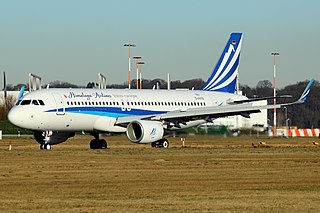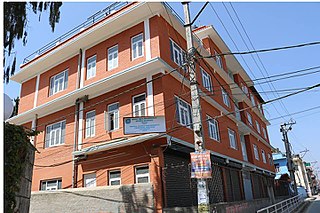
Kangchenjunga, also spelled Kanchenjunga, is the third highest mountain in the world. It rises with an elevation of 8,586 m (28,169 ft) in a section of the Himalayas called Kangchenjunga Himal delimited in the west by the Tamur River, in the north by the Lhonak Chu and Jongsang La, and in the east by the Teesta River. It lies between India and Nepal, with three of the five peaks, namely Main, Central and South, directly on the border, and the peaks West and Kangbachen in Nepal's Taplejung District.

The Himalayas, or Himalaya are a mountain range in Asia separating the plains of the Indian subcontinent from the Tibetan Plateau. The range has some of the planet's highest peaks, including the highest, Mount Everest. Over 100 peaks exceeding 7,200 m (23,600 ft) in elevation lie in the Himalayas. By contrast, the highest peak outside Asia is 6,961 m (22,838 ft) tall.

Nepal, officially the Federal Democratic Republic of Nepal, is a landlocked country in South Asia. It is mainly situated in the Himalayas, but also includes parts of the Indo-Gangetic Plain, bordering Tibet of China to the north, and India in the south, east, and west, while it is narrowly separated from Bangladesh by the Siliguri Corridor, and from Bhutan by the Indian state of Sikkim. Nepal has a diverse geography, including fertile plains, subalpine forested hills, and eight of the world's ten tallest mountains, including Mount Everest, the highest point on Earth. Nepal is a multi-ethnic, multi-lingual, multi-religious and multi-cultural state, with Nepali as the official language. Kathmandu is the nation's capital and the largest city.

The International Mountaineering and Climbing Federation or UIAA recognises eight-thousanders as the 14 mountains that are more than 8,000 metres (26,247 ft) in height above sea level, and are considered to be sufficiently independent from neighbouring peaks. However, there is no precise definition of the criteria used to assess independence, and, since 2012, the UIAA has been involved in a process to consider whether the list should be expanded to 20 mountains. All eight-thousanders are located in the Himalayan and Karakoram mountain ranges in Asia, and their summits are in the death zone.

The Dhaulagiri massif in Nepal extends 120 km (70 mi) from the Kaligandaki River west to the Bheri. This massif is bounded on the north and southwest by tributaries of the Bheri River and on the southeast by the Myagdi Khola. Dhaulagiri is the seventh highest mountain in the world at 8,167 metres (26,795 ft) above sea level, and the highest mountain within the borders of a single country (Nepal). It was first climbed on 13 May 1960 by a Swiss/Austrian/Nepali expedition.

Pokhara is a metropolitan city in Nepal, which serves as the capital of Gandaki Province. It is the country's largest metropolitan city in terms of area and second-largest in terms of population. The city also serves as the headquarters of Kaski District. Pokhara is located 200 kilometres west of the capital, Kathmandu. The city is on the shore of Phewa Lake, and sits at an elevation of approximately 822m. The Annapurna Range, with three out of the ten highest peaks in the world—Dhaulagiri, Annapurna I and Manaslu—is within 15–35 mi (24–56 km) of the valley.
Lieutenant Colonel James Owen Merion Roberts MVO MBE MC was one of the greatest Himalayan mountaineer-explorers of the twentieth century; a highly decorated British Army officer who achieved his greatest renown as "the father of trekking" in Nepal. His exploratory activities are comparable to those of Eric Shipton and Bill Tilman.

The Digital Himalaya project was established in December 2000 by Mark Turin, Alan Macfarlane, Sara Shneiderman, and Sarah Harrison. The project's principal goal is to collect and preserve historical multimedia materials relating to the Himalaya, such as photographs, recordings, and journals, and make those resources available over the internet and offline, on external storage media. The project team have digitized older ethnographic collections and data sets that were deteriorating in their analogue formats, so as to protect them from deterioration and make them available and accessible to originating communities in the Himalayan region and a global community of scholars.

Elizabeth Hawley was an American journalist, author, and chronicler of Himalayan mountaineering expeditions. Hawley's The Himalayan Database became the unofficial record for climbs in the Nepalese Himalaya. She was also the honorary consul in Nepal for New Zealand.

The geology of Nepal is dominated by the Himalaya, the highest, youngest and a very highly active mountain range. Himalaya is a type locality for the study of on-going continent-continent collision tectonics. The Himalayan arc extends about 2,400 km (1,500 mi) from Nanga Parbat by the Indus River in northern Pakistan eastward to Namche Barwa by the gorge of the Tsangpo-Brahmaputra in eastern Tibet. About 800 km (500 mi) of this extent is in Nepal; the remainder includes Bhutan and parts of Pakistan, India, and China.

The Himalayan brown bear, also known as the Himalayan red bear, isabelline bear or Dzu-Teh, is a subspecies of the brown bear and is known from northern Afghanistan, northern Pakistan, northern India, west China and Nepal. It is the largest mammal in the region, males reaching up to 2.2 m (7 ft) long, while females are a little smaller. The bears are omnivorous and hibernate in dens during the winter. While the brown bear as a species is classified as Least Concern by the IUCN, this subspecies is highly endangered and populations are dwindling.
Badi is a Hill Dalit community in Nepal. The 1854 Nepalese Muluki Ain categorized Badi as "Impure and Untouchable " category. Badi are categorized under "Hill Dalit" among the 9 broad social groups, along with Damai, Sarki, Kami and Gaine by the Government of Nepal. 'Badi' means Vadyabadak, one who plays musical instruments, in Sanskrit. Sometimes called untouchables among the untouchables, they support their impoverished families through daily wages and fishing, woodcutting and making musical instruments.

Mark Turin is a British anthropologist, linguist and occasional radio broadcaster who specializes in the Himalayas and the Pacific Northwest. From 2014–2018, he served as Chair of the First Nations and Endangered Languages Program and Acting Co-Director of the Institute for Critical Indigenous Studies at the University of British Columbia in Vancouver. He is an Associate Professor at the University of British Columbia, cross-appointed between the Department of Anthropology and the Institute for Critical Indigenous Studies.

The following outline is provided as an overview of and topical guide to Nepal:

Sushma Joshi is a Nepali writer, filmmaker based in Kathmandu, Nepal. Her fiction and non-fiction deal with Nepal's civil conflict, as well as stories of globalization, migration and diaspora.

Girardinia diversifolia, commonly known as the Himalayan nettle or Nilghiri nettle, is found abundantly in open forest land, river sides, and moist habitat in Nepal and in Himalayan parts of India such as Uttarakhand, Himachal Pradesh and Jammu and Kashmir and in vast parts of China. It grows naturally at elevations between 1,200 to 3,000 metres. It is a shade tolerant, tall, stout and erect herb growing up to 3m height with perennial rootstock. The plant grows as a clump, and each clump has many stems. The stem contains bast fiber of unique quality which is strong, smooth and light.
Drona Prakash Rasali was a Nepalese student who stood Board First position topping School Leaving Certificate (Nepal) i.e. national board examinations of Nepal, commonly abbreviated as SLC, held in 1972. He is the only one person so far from Dalit communities of Nepal, to obtain the most coveted rank in the history of SLC Board Examinations.

Himalaya Airlines is a Nepalese airline operating from Tribhuvan International Airport in Kathmandu, Nepal. Himalaya Airlines was founded in 2014 as a joint venture between Yeti World Investment Group and Tibet Airlines. It launched operations in May 2016 with a single Airbus A320. The airline flies to ten destinations as of 24 January 2020.

Deepak Shimkhada is a Nepali American educator, artist, art historian, author and community leader. He currently serves as an adjunct professor at Chaffey College in Rancho Cucamonga, California. He has previously held visiting and adjunct appointments at several universities in the United States, including Scripps College, Claremont Graduate University, California State University, Northridge, University of the West, and Claremont School of Theology]]. His teaching career began in 1980 and although he is fully retired from full-time teaching, he currently teaches Asian art part-time at Chaffey College.

Nepal Open University formally established in 2016 in Nepal, with endorsement of Nepal Open University act by the parliament of Nepal. This is the premier Open University in Nepal with a legal status on par with other universities in the country. It has its main campus in Lalitpur, Nepal.















